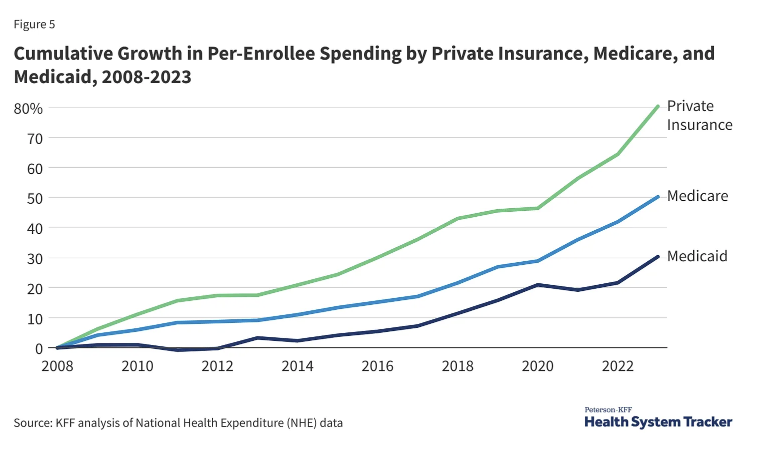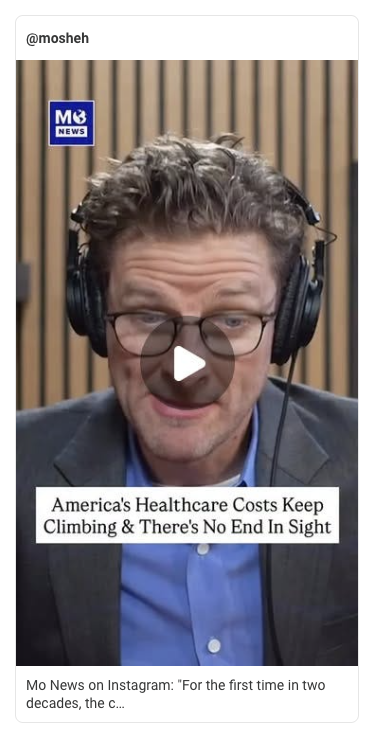Government Is Open, But Healthcare Crisis Remains
The federal government is open after a historic 43-day shutdown. President Trump signed the government funding bill Wednesday night after the House voted to approve the measure.
Clock’s already started: Nearly every Republican in the House — along with 6 Democrats — voted for the bill, which sets up a new funding deadline for Congress on January 30.
Some critical programs — like SNAP food stamps, which weren’t funded for the first time in the recent shutdown — will be immune from future political fights, as the bill provides funding for a few key agencies through the remainder of fiscal year 2026.
Full SNAP benefit payments could take up to 10 days to be issued.
Shutdown headaches persist: While federal employees are back to work today, many will only start receiving backpay on Saturday — others not until Wednesday, a White House memo outlines. It comes as new analysis estimates 24% of U.S. households live paycheck to paycheck.
Flight cancellations and delays are improving, but about 1,000 flights were still canceled today. The FAA says it will not increase required cancellations as originally planned, pausing at its current level of 6%.
The impacts of the shutdown: 42 million people lost their SNAP benefits; hundreds of thousands of federal workers were furloughed or worked without pay; 60,000 people lost their job in the private sector; $11 billion was lost in inflation-adjusted GDP value — and the ripple effects are expected to last weeks, especially when it comes to travel issues.
It was a lot of pain and in the end, no deal on healthcare — which was the whole reason Democrats held out on voting for the spending bill. It’s making some question: was it all worth it?
GOVT OPEN, HEALTHCARE BROKEN
Ultimately, Democrats fell short of their goal to guarantee an extension of Affordable Care Act (ACA) health insurance subsidies set to expire at the end of the year. The fight over subsidies impacts about 22 million Americans, but another tens of millions of Americans are also dealing with premium spikes and rising healthcare costs that have outpaced inflation.
The New York Times broke down the average, unsubsidized annual cost of health insurance plans for a single adult in 2025 (mind you: each program covers different populations, different medical needs, and different providers):
Because ACA premiums remain high — and are expected to rise by an average of 18% next year — the subsidies are crucial to afford these plans, Mosheh explained in a recent #AMA premium podcast. “So, as far as Democrats are concerned — and now some Republicans — we need the subsidies to continue, because otherwise millions of Americans will fall off insurance.”
The ACA, also dubbed Obamacare, has allowed for more people to get health care coverage — it’s main goal. But, that expanded coverage was meant to bring down the costs of premiums, which it has not.
Before the law passed, about 14–16% of Americans were uninsured; by 2023, that fell to a record low of about 8%, driven mostly by Medicaid expansion and new insurance marketplaces offering financial help for premiums.
Overall, the law has grown in popularity, as it includes provisions like mandated coverage for preexisting conditions, caps on out-of-pocket costs for in-network coverage, free preventive care, and allows young adults to stay on their parents’ plans until age 26.
When a Democratic-led Congress expanded tax credits for the ACA in 2021, enrollment grew from 11 to over 24 million policyholders. If those go away, premiums will more than double on average and millions are expected to opt out of coverage all together.
COSTS ARE SOARING
Regardless, premiums and deductibles are rising. That’s because drug companies, pharmacy benefit managers, hospitals, and others have driven health care costs up. Critics also argue the ACA’s required benefits made coverage more expensive for everyone, as we all pitch in to cover those costs.
What Congress has done: The ACA did not take away the power of private insurers, drug makers, and hospital systems to charge more. And the U.S. government does far less price-setting than other wealthy countries.
Republicans spent years trying to repeal Obamacare entirely — and nearly succeeded during Trump’s first term (remember Sen. John McCain’s (R-AZ) thumbs-down vote on the Senate floor?).
Now some Republicans are now proposing sending health subsidies directly to Americans instead of sending money to insurance companies; but that would still not fix underlying price issues.
What Trump’s doing: The White House has been negotiating directly with drug companies to bring down the price of certain medications, and it plans to launch a new direct-to-consumer website, TrumpRx.gov, next year. Trump continues to say he will repeal Obamacare, but has only ever mentioned “concepts of a plan” to replace it.
Bottom line: Without subsidies, millions could lose coverage, potentially leading to more ER visits, which would drive premiums up for everyone else. In just two months, we could face the exact same showdown again as House Speaker Mike Johnson (R-LA) does not seem inclined to bring a vote on extending the subsidies.
HOW PEOPLE ARE COPING
Health coverage has gotten so expensive that people — even celebrities — are turning to crowdfunding-like methods to pay their medical bills.
Actor James Van Der Beek, 48, is auctioning off cherished memorabilia from his career, like items from Dawson’s Creek, to help cover the costs of fighting stage 3 colorectal cancer.
Everyday Americans are also facing impossible choices: Sunni Montgomery, 63, has been fighting lung cancer since 2022 on her ACA marketplace plan. Without subsidies, her premium is set to triple to $1,758/month.
“I have to face the reality that I am probably going to become a late-stage cancer patient who’s uninsured,” Montgomery told CNN. “I have fought this so hard. I want to live.”




